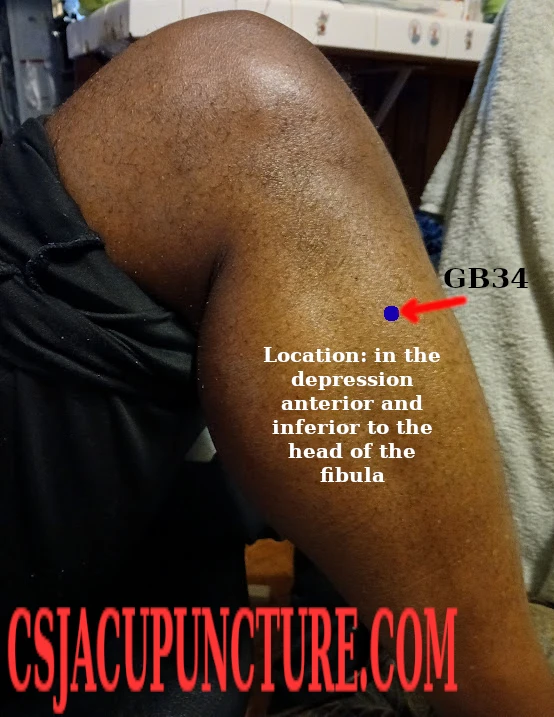This post may contain affiliate links and ads in which we may earn a small percentage of purchases.
Table of Contents
Acupuncture point GB34, known as Yanglingquan, or “Hill Spring”, is a significant point in the treatment of many conditions locally, along the channel, and within the body. This article explores GB34’s acupuncture point location, it’s function based on Traditional Chinese Medicine (TCM) and bio-medical physiology, current research and videos related to this commonly used acupuncture point.
Location of GB34
GB34 is located on the lateral aspect of the lower leg, specifically in the depression anterior and inferior to the head of the fibula1.
To find GB34:
- Sit with your knee slightly bent.
- Locate the bony prominence (head of the fibula) on the outside of your lower leg, just below the knee.
- GB34 is in the depression just in front of and below this bony prominence.

Functions Based on Traditional Chinese Medicine (TCM) Theory
In TCM, GB34 is a crucial point with key functions:
A clear and beginner-friendly guide covering over 400 acupuncture points, ideal for students and learners.
 View Book
View Book
A stainless-steel acupuncture pen and gua sha set for massage, reflexology, and tension relief.
 View Product
View Product
- Lower He-Sea Point: GB34 is the Lower He-sea point of the gallbladder and is considered specifically connected to the gallbladder from a TCM perspective.
- Hui-Meeting Point of Sinews: GB34 is known as the influential point of the sinews, meaning it has a strong effect on the muscles and tendons. It is commonly used to treat musculoskeletal disorders, including stiffness, pain, and spasms.
- Regulates Liver and Gallbladder Qi: GB34 is essential for regulating the flow of Qi in the Liver and Gallbladder meridians. It helps to smooth Liver Qi, which can alleviate emotional disorders such as irritability, anger, and frustration.
- Clears Damp-Heat: This point is effective in clearing damp-heat from the Liver and Gallbladder. Damp-heat conditions can manifest as jaundice, bitter taste in the mouth, and digestive issues.
- Benefits the Joints: GB34 is frequently used to treat joint pain and disorders, including arthritis and rheumatism. It helps in reducing inflammation and improving joint mobility.
Biomedical Functions
From a biomedical perspective, GB34 has several notable functions:
Liver / Gallbladder function: Hypochondriac pain, jaundice, hepatitis, acute biliary tract diseases, cirrhosis of the liver and hypertension.2
- Pain Relief and Anti-Inflammatory Effects: Stimulating GB34 has been shown to release endorphins and other neurotransmitters that help reduce pain and inflammation. This makes it effective for treating conditions such as tendonitis, bursitis, and other musculoskeletal pain.
- Improves Flexibility and Mobility: GB34 helps in enhancing the flexibility and mobility of the muscles and joints. It is often used in sports medicine to aid in the recovery of injuries and improve athletic performance. Being close the the knees, it may also be beneficial for knee pain.
- Neuroprotective Effects: Research has indicated that stimulating GB34 may have neuroprotective benefits, potentially benefiting conditions such as parkinson’s and possibly other neurodegenerative diseases. It may aid in improving motor function and reducing neurological deficits.
- Mental Health Benefits: By regulating the autonomic nervous system and balancing neurotransmitters, GB34 can help reduce anxiety, stress, and depression. It promotes a sense of calm and well-being.
Clinical View of Acupuncture Point GB34
Here are my thoughts on the gall bladder 34 (GB34) acupuncture point:
GB34 is often referred to as a powerful point. This usually indicates that it can initiate a strong response in terms of sensation when the needle is inserted, or it might reflect the overall effectiveness of treatment in improving the condition. It is one of those points that can have a strong effect, much like stomach 36 (ST36), not stomach 34. ST36 is a great point because you can press on it and see immediate relief in certain areas. Some points, like GB34, provide noticeable effectiveness quickly, regardless of location or other factors.
Why I Use GB34
We were taught, and I believe it was my clinician Dr. Sam Hwang who said, that you don’t use GB34 and ST36 at the same time because they are very strong points and are located quite close together. They’re practically on the same level.
Accessibility For Patients Lying Prone
I often use GB34 when patients are lying face down, and I don’t have access or the ability to insert a needle into ST36. The location of GB34 makes it suitable for treating the lower extremities as well as the back, including the low back, hips, and vastus lateralis.
Liver and Gallbladder Meridian
GB34 is located directly into the fibularis longus and is part of the gallbladder meridian. Therefore, it is used for conditions related to the liver and gallbladder, such as migraines and anger issues. I usually couple this point with UB57, UB25, and UB27 for comprehensive treatment of the low back.
Research
Parkinson’s
Parkinson’s disease is a condition that affects movement due to low levels of a brain chemical called dopamine.
A group of 12 patients with Parkinson’s were compared with a group of 12 healthy participants. Acupuncture was conducted on a specific acupuncture point, GB 34 (Yanglingquan) on the right side, which is a frequently used acupoint for motor function treatment.
The reseachers of the study found that performing the acupuncture at the gb34 point activated areas in the brain such as the prefrontal cortex and precentral gyrus.3
Despite limitations of the study, more research can help to provide more information on the mechanisms and potential uses.
Hepatoprotective
A study was conducted in 2006 to examine the Hepatoprotective (ability to protect liver cells) of GB 34 in rats. Manual acupuncture at GB34 reduced the liver index, serum ALT, AST, ALP and total cholesterol levels as
compared with the control group and the sham acupuncture group4. It also increased and normalized the populations of WBC and lymphocytes.5
Electrical Skin Resistance
A 2008 study found that electrical skin resistance (ESR) at acupuncture points can not only be lower but also higher compared to the surrounding area. The researchers also found significant changes in ESR at the acupuncture point GB34 in a total 33.3% of measurements (out of 81 participants).6
Acupuncture point GB34 is a versatile and powerful point with numerous applications in both TCM and biomedicine. Its location on the lateral lower leg makes it easily accessible for treating a wide range of conditions, from musculoskeletal disorders to digestive and mental health issues. By understanding the functions of GB34, practitioners can effectively incorporate this point into their acupuncture treatments to enhance patient health and well-being.
Videos on Gallbladder 34 (GB34)
GB 34 Acupuncture Point – Acupro Academy
References:
- Deadman, P., Al-Khafaji, M., & Baker, K. (2007). A Manual of Acupuncture. Journal of Chinese Medicine Publications.
- Maciocia, G. (2005). The Foundations of Chinese Medicine: A Comprehensive Text. Churchill Livingstone.
- Cheng, X. (Ed.). (1999). Chinese Acupuncture and Moxibustion. Foreign Languages Press.
- Sun N, He D, Ye X, et al
Immediate acupuncture with GB34 for biliary colic: protocol for a randomised controlled neuroimaging trial
BMJ Open 2022;12:e050413. doi: 10.1136/bmjopen-2021-050413 ↩︎ - Yim, Y. K., Lee, H., Hong, K. E., Kim, Y. I., Lee, B. R., Kim, T. H., & Yi, J. Y. (2006). Hepatoprotective effect of manual acupuncture at acupoint GB34 against CCl4-induced chronic liver damage in rats. World journal of gastroenterology, 12(14), 2245–2249. https://doi.org/10.3748/wjg.v12.i14.2245 ↩︎
- Yeo, S., Choe, I. H., van den Noort, M., & others. (2014). Acupuncture on GB34 activates the precentral gyrus and prefrontal cortex in Parkinson’s disease. BMC Complementary and Alternative Medicine, 14, 336. https://doi.org/10.1186/1472-6882-14-336 ↩︎
- Yim, Y. K., Lee, H., Hong, K. E., Kim, Y. I., Lee, B. R., Kim, T. H., & Yi, J. Y. (2006). Hepatoprotective effect of manual acupuncture at acupoint GB34 against CCl4-induced chronic liver damage in rats. World journal of gastroenterology, 12(14), 2245–2249. https://doi.org/10.3748/wjg.v12.i14.2245 ↩︎
- “” ↩︎
- Kramer, S., Zaps, D., Wiegele, B., & Irnich, D. (2008). Changes in electrical skin resistance at Gallbladder 34 (GB34). Journal of Acupuncture and Meridian Studies, 1(2), 91-96. https://doi.org/10.1016/S2005-2901(09)60028-5 ↩︎
Medical Disclaimer: This article is for informational and educational purposes only and is not a substitute for professional medical advice, diagnosis, or treatment. Always consult a qualified healthcare provider with any questions about a medical condition or treatment.






